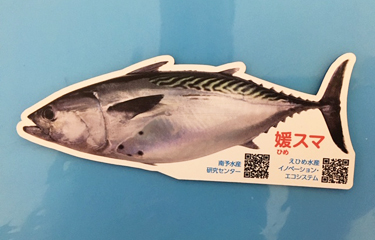Ehime University introduced a new farmed tuna species at last month’s Seafood Show Osaka 2020, which is it aiming to market throughout Japan.
The eastern little tuna, or mackerel tuna (Euthynnus affinis), is called suma or kawakawa in Japanese. The species is distributed in the temperate and tropical waters of the Indian and Pacific oceans, including southern Japan.
Professor Satoshi Kanao, of the university’s South Ehime Fisheries Research Center, described the meat as resembling chu-toro (medium fatty bluefin tuna). In appearance, it is between a tuna and mackerel, he said.
They do not form large schools like skipjack tuna, but rather, form small groups in shallow coastal waters. This makes it harder for commercial fishermen to target them, thus making them less commonly available to Japanese consumers. However, they have some positive points as a subject for aquaculture. Suma is harvested at a size of around 1.5 kilograms, so it can be reared in the same net pens used for red sea bream and yellowtail. Ehime Prefecture, on Shikoku Island facing the Seto Inland Sea, is already a center for red sea bream and yellowtail farming. Bluefin tuna aquaculture, in contrast, requires larger net-pens. Suma can also reach maturity and reproduce in as little as 12 months in temperature-controlled tanks, allowing easier maintenance of broodstock than larger tuna species.
The short maturation period also allows rapid selective breeding, according to Kanao. Traits that are selected for are ability to withstand cold temperatures, ability to mature and breed within one year, and rapid weight gain. The research center has developed a “Next-Generation Breeding System (NGBS)” to breed a “super elite” genetic line of suma. In this system, donor germ cells from rapid gaining fish are isolated, cryopreserved, and then implanted to sterilized early maturing host fish to produce germline chimeras. The chimera has the reproductive cells of the superior donor fish.
The university is offering its product under the brand name “Himesuma,” incorporating the “hime” (meaning “princess”) from Ehime Prefecture.
Photo courtesy of Chris Loew/SeafoodSource







